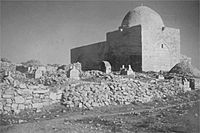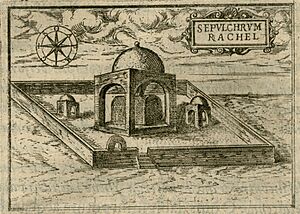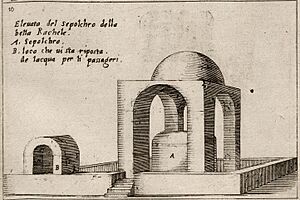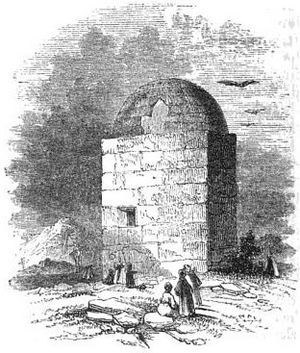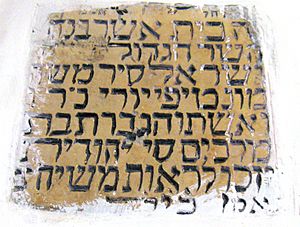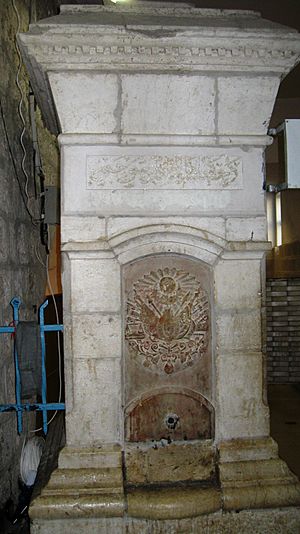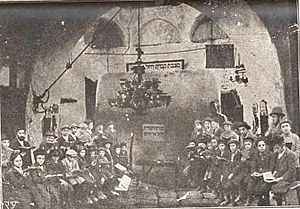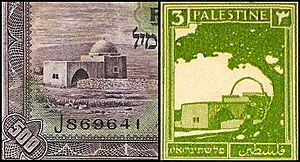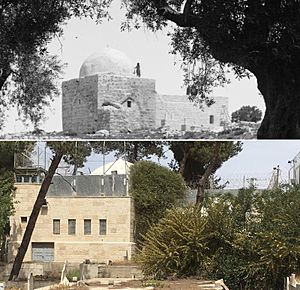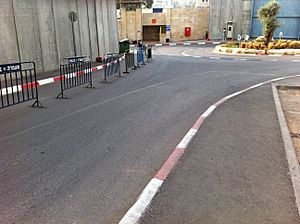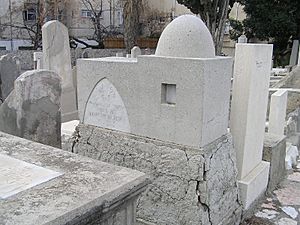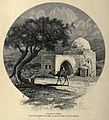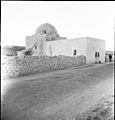Rachel's Tomb facts for kids
|
Kever Rachel (Hebrew); Qabr Raheel (Arabic)
|
|
|
Historical photo of Rachel's Tomb from 1926/Sarcophagus
|
|
| Location | near Bethlehem |
|---|---|
| Region | West Bank |
| Coordinates | 31°43′10″N 35°12′08″E / 31.7193434°N 35.202116°E |
| Palestine grid | 1691/1251 |
| Type | tomb, prayer area |
| History | |
| Founded | Ottoman |
| Cultures | Jews, Muslims, Christians |
| Site notes | |
| Management | Israeli Ministry of Religious Affairs |
| Public access | Limited |
| Website | keverrachel.com |
| Venerated as the third holiest site in Judaism | |
Rachel's Tomb is a special place where many people believe the Biblical mother Rachel was buried. It is also known as the Bilal bin Rabah mosque. This site is important to Jews, Christians, and Muslims. It is located near the city of Bethlehem in the West Bank. The building looks like a traditional maqam, which is an Arabic word for a shrine.
Some scholars debate the exact burial spot of Rachel. However, this site is the most widely accepted location. The earliest records mentioning this tomb as Rachel's burial place are from the early 300s CE. The building you see today was built during the Ottoman period. It stands in a cemetery that has been used by Christians and Muslims for a very long time.
In 1841, Sir Moses Montefiore helped fix up the site. He added a room for Muslim prayer to make sure everyone felt welcome. Throughout history, this place has been respected by all three religions. Today, it is considered the third holiest site in Judaism. It is a very important symbol for Jewish-Israeli identity.
After 1967, Israel took control of the West Bank. The tomb's status was set in 1995 by the Oslo II Accord. This agreement made Israel responsible for the site's security. In 2005, a barrier was built around the tomb, connecting it to Jerusalem. This made it harder for Muslims and Christians to visit. In 2010, UNESCO stated that Rachel's Tomb is part of Palestine.
Contents
Biblical Accounts and Location Debate
The Hebrew Bible has two ideas about where Rachel was buried. One idea places it north of Jerusalem, near Ramah. The other places it close to Bethlehem.
Northern vs. Southern Story
In the Book of Genesis, Rachel and Jacob travel from Shechem to Hebron. Rachel dies on the way while giving birth to Benjamin. The Bible says she was buried "on the way to Ephrath, which is Bethlehem." A pillar was set up there to mark her grave.
Some experts believe the Bethlehem location was added later. They think Rachel's tomb was originally in the northern area, in Benjamin's territory. The Books of Samuel also suggest a northern location for Rachel's tomb.
The Bethlehem Building
Around 1825, people dug near the Bethlehem building. They found that the structure was not built directly over an underground cave. However, a deep cave was found a short distance away.
History of the Site
The tomb has a long and interesting history. Many different groups have cared for and visited it over the centuries.
Early Times
Stories about the tomb at this spot go back to the early 300s AD. Writers like Eusebius and the Bordeaux Pilgrim mentioned it. They said it was about 4 miles from Jerusalem.
Middle Ages
In the late 600s, the tomb had a simple stone pyramid. By the 1100s, Muhammad al-Idrisi described it as having a dome. Benjamin of Tudela was the first Jewish pilgrim to write about visiting the tomb in the late 1100s. He mentioned a pillar made of 11 stones.
During the 1300s, the tomb was described as a very strong structure. From the 1400s, Muslim rulers took care of the tomb. It was seen as a mosque in 1421. Many travelers noted that Jews, Muslims, and Christians all respected the site.
Ottoman Period (1500s-1900s)
In 1615, the Pasha of Jerusalem gave Jews special use of the site. However, the building was repaired by locals many times. In 1632, George Sandys noted that Muslims used a part of the sepulchre for prayer.
In the 1700s, walls were built around the arches. This was possibly to stop Jews from entering. However, the site was still important to Turks for burials.
In the 1800s, the tomb was described as a square building with a dome. It was seen as a Muslim shrine. The inside walls were covered with Hebrew names.
Sir Moses Montefiore visited the tomb in 1828. He was very moved by it. In 1841, he fixed up the entire building. He added an extra room with a mihrab (a prayer niche) for Muslims. This was to make sure Muslims felt comfortable using the site.
By the mid-1800s, the local Arab tribe demanded money from Jews to prevent damage to the tomb. Jewish pilgrims, especially women, often visited the tomb. They prayed there for successful childbirth.
In 1869, there were rumors that Christians wanted to buy land around the tomb. Later, land near the tomb was bought by Nathan Straus and Rabbi Zvi Hirsch Kalischer for Jewish use.
British Mandate Period (1917-1948)
After the British took control, the site was cleaned. However, when Jews asked to make repairs, local Muslims objected. The British government then decided to handle all repairs.
During this time, both Jews and Muslims visited the site. It became a symbol of the Jewish people returning to their homeland. For Jewish women, it was a place to pray for fertility. Muslims used the mosque inside and the nearby cemetery for burials. People generally respected each other's traditions.
In 1929, violence made it hard for Jews to visit. Both Jews and Muslims wanted control of the site. Muslims said it was part of their cemetery.
Jordanian Period (1948-1967)
After the 1948 war, Jordan controlled the area. The site was managed by the Islamic waqf (religious trust). The UN said that everyone should have free access to holy places. However, Israelis could not enter Jordan, so they could not visit the tomb. Non-Israeli Jews could still visit. During this time, the Muslim cemetery grew larger.
Israeli Control (1967-Present)
After the Six-Day War in 1967, Israel took control of the West Bank. The tomb was put under Israeli military rule. Islamic symbols inside the building were removed. Muslims were stopped from using the mosque. Later, they were also barred from using the cemetery.
Oslo Agreements and Security
In 1995, the Oslo II Accord placed Rachel's Tomb in a Palestinian area. However, Israel kept security control over the tomb and its access road. This was a special agreement.
Palestinian leader Yasser Arafat was against Israel controlling the road. But he agreed so that the peace talks could continue. In December 1995, Bethlehem came under Palestinian control, but the tomb remained under Israeli security.
Fortification and Barrier

In 1996, Israel began to fortify the site. They built a high wall and a military post. After an attack on another holy site, Rachel's Tomb was also attacked. Young Palestinians threw stones and firebombs. Israeli soldiers responded with tear gas.
In 2000, during the Second Intifada, the tomb was attacked for 41 days. In 2002, Israel built a concrete wall and watchtowers around the tomb. This effectively added it to Jerusalem. The Israeli Supreme Court approved this in 2005.
In 2010, Israeli Prime Minister Netanyahu said the tomb would be part of Jewish heritage sites. The Palestinian Authority and Jordan opposed this. UNESCO also urged Israel to remove it from its heritage list. UNESCO stated that the site is part of Palestinian territories. They recognized its importance to both Judaism and Islam.
Jewish Religious Importance
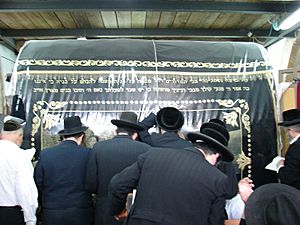
In Jewish stories, Rachel died on the 11th of Cheshvan. This was in 1553 BCE.
Rabbinic Stories
- The first person to pray at Rachel's tomb was her son, Joseph. He ran to her grave when he was being taken to Egypt as a slave. He cried out, and his mother's voice comforted him.
- There are reasons why Rachel was buried by the road, not in the Cave of the Patriarchs.
- Jacob knew that Jews would be exiled to Babylon. They would pass her grave and be comforted by her. She would pray for them, and God would listen.
- Rachel died suddenly, so Jacob could not take her body to Hebron.
- Jacob did not want to bury Rachel in Hebron. He did not want to seem ashamed before his ancestors for having two wives.
- The mystical book, Zohar, says that when the Messiah comes, he will lead the Jews back to Israel along the road past Rachel's grave.
Location in Jewish Tradition
Jewish scholars noticed a difference in the Bible about Rachel's grave. Genesis says it is "on the way to Ephrath, which is Bethlehem." But Samuel says it is in Benjamin's territory.
Some scholars believe the site near Bethlehem is the true location. They think the reference in Jeremiah to Ramah is a story, not a literal location.
Customs at the Tomb
A Jewish tradition says Rachel cries for her children. She wept as they passed her grave on their way to exile in Babylon. Jews have visited the tomb for a very long time.
There was a special key for the tomb. It was said to help expectant mothers with labor pains. The key was placed under their pillow.
Today, a famous custom for women is to tie a red string around the tomb seven times. Then, they wear it as a charm for fertility.
The Torah Ark inside Rachel's Tomb has a curtain. It is made from the wedding dress of Nava Applebaum. She was a young Israeli woman killed in 2003.
Connection to Bilal ibn Rabah
Palestinian sources say the building was a mosque. It was built to honor Bilal ibn Rabah. He was an Ethiopian who was the first muezzin (caller to prayer) in Islamic history.
Replicas of the Tomb
The tomb of Sir Moses Montefiore in England is a copy of Rachel's Tomb.
In 1934, Michigan Memorial Park planned to build a replica. It was used for sound systems during funerals. However, it has since been taken down.
See also
 In Spanish: Tumba de Raquel para niños
In Spanish: Tumba de Raquel para niños
- List of National Heritage Sites of Israel
Images for kids
Gallery
North-east perspective
- Mid 1990s North-east perspective available externally:
- 2008 picture of the same North-east perspective:
North perspective
West perspective
East perspective
- A 2014 photo from Hebrew Wikipedia:
South perspective
South-east perspective


